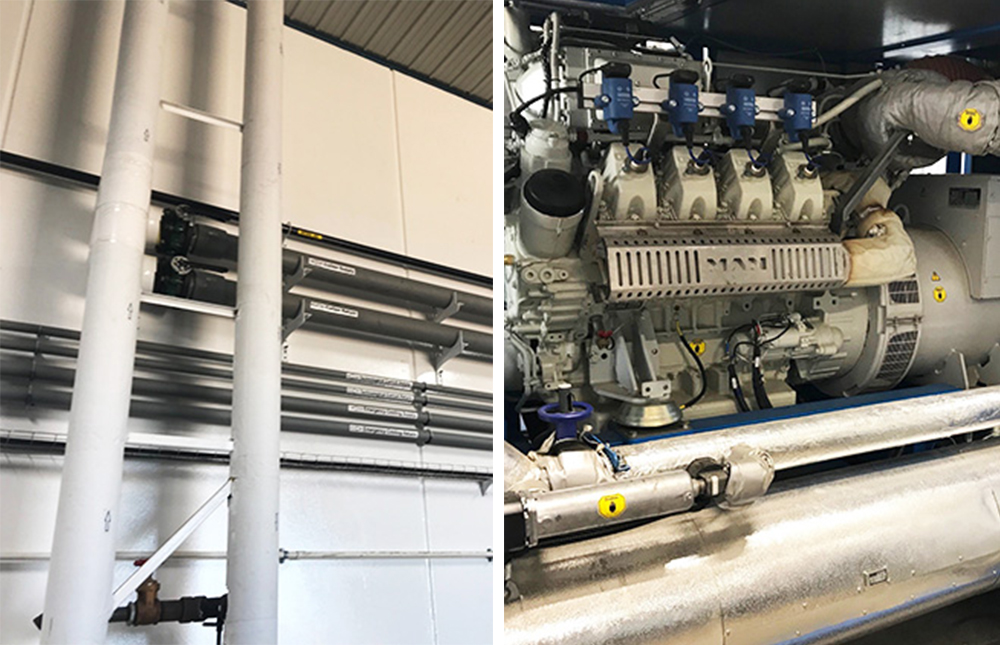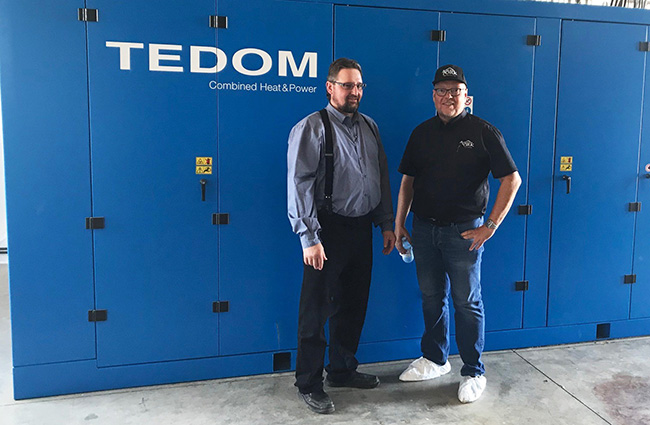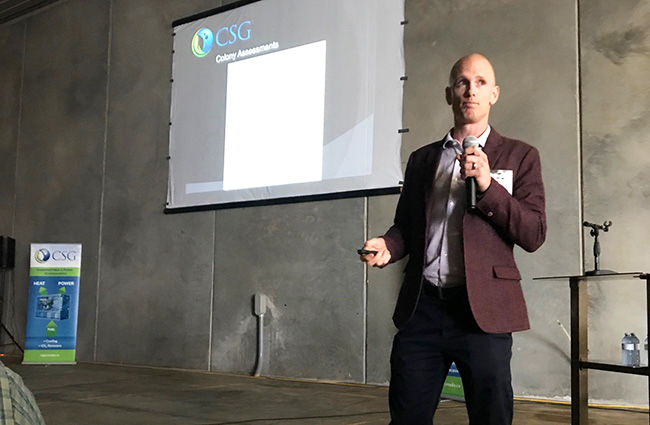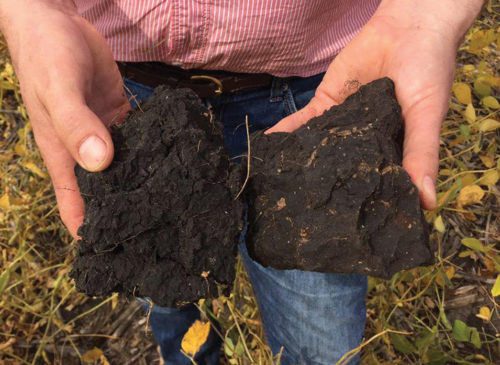An Alberta pork producer is taking a large environmentally sustainable leap, thanks to a new heat recovery unit that will help improve operational profitability and self-reliance. The new unit adds to the producer’s existing suite of carbon-neutralizing tools, which includes conservation cropping to earn “tillage credits.”
Cogeneration, or combined heat and power (CHP), is the use of a prime mover engine to generate electricity and heat at the same time. A new CHP unit was unveiled on August 8 at Hartland Colony near Bashaw, about 130 kilometres southeast of Edmonton. The unveiling event welcomed more than 100 producers, industry partners and community members to learn more about the technology and celebrate the accomplishment. Hartland’s use of CHP as part of their farming operation in Alberta is turning heads as this technology starts to take hold outside of Europe.
Hartland’s CHP unit took under two weeks to install and has been up and running at 85 per cent capacity since mid-May 2019. Approximately 90 per cent of all recovered heat can be used during nine months of the year, which translates into a 35 per cent reduction in overall energy costs or more than $230,000 per year. In just under three years, the system is expected to have paid for itself, while the life of the equipment is estimated to be 15 years.

“Consumers want to see how producers are ‘going green.’ By adopting systems like CHP, we can say the pork industry is moving in the right direction,” said Darcy Fitzgerald, Executive Director, Alberta Pork. “Staying competitive in the global market today means that you have to cater to consumers who are better-informed and more conscientious than ever before.”
CHP works by taking a single fuel source (natural gas, in this case) and outputting two types of energy: heat and electricity. Depending on the ambient air temperature, which changes dramatically from season to season in Alberta, the system automatically regulates its internal environment by preheating intake air or rejecting excess engine heat as required.
“Our electricians started looking for ways that we could save costs, and when they looked into CHP, they thought it was a good idea. We crunched the numbers and determined it was worthwhile to pursue,” said Martin Waldner, Hartland’s hog barn manager and board director with Alberta Pork. “Before making our decision, we went over to Europe to see what kinds of units were being used there. Everyone we spoke to was satisfied with their experience using CHP.”

Hartland’s starting point in evaluating the potential of CHP was to measure the colony’s emissions and energy consumption, which included everything from the hog barn, feed mill, canola crushing plant and other on-farm processes, in addition to residential demands. Once that information had been collected, it was plugged into a return-on-investment (ROI) calculator to determine exactly how much benefit a CHP system could bring.
To further understand the implications of CHP, the colony worked with Airdrie-based CSG Canada to model the data using the company’s proprietary software. By analyzing the data models, it was possible to determine the colony’s peak and minimum demands (their highest and lowest electricity usage rates) to find out how and when power was being drawn. CSG’s goal is to drive change to smarter energy use while seeing a lasting, transformational benefit from doing so.
“Higher energy costs and carbon offset incentives make Alberta a natural fit for CHP,” said Matt Alfke, Sales Manager, CSG. “Colonies and other large producers with high energy demands especially can take advantage of these highly customizable systems, which we tailor according our clients’ unique needs.”

In Europe, CHP technologies have been a mainstay for more than three decades. In Canada, they are just starting to make waves. In Alberta today, operational CHP systems are in use at the University of Alberta and Calgary’s Chinook Mall, among other locations. The technology has even been adopted by recreation centres, grocery stores and property developers.
There are a variety of CHP systems available around the world. One such manufacturer is TEDOM of the Czech Republic. In North America, TEDOM products are distributed by Calgary-based Co-genergy Corporation, which helped connect Hartland to their unit of choice. The company’s objective is to bring turn-key cogeneration and trigeneration solutions to clients in various sectors, including agriculture, healthcare, oil and gas, manufacturing and more.
Currently, a 1,100-kilowatt CHP system is being built in Lethbridge by Co-genergy to produce dried hay and corn silage animal feed for domestic use and export—major progress for using CHP to lower the cost of feed for livestock producers.
“It is very encouraging for Co-genergy and TEDOM to find Alberta farmers receptive to this well-established technology, realizing the benefits to livestock farming in colder climate regions,” said Chris Cilia, President, Co-genergy Corporation. “Sustainability is key in farming, and CHP and other technologies have a lot of potential to help agriculture become more efficient in this competitive sector.”
TEDOM’s units come in several sizes and can be installed outdoors or indoors—factors that are considered when designing a functional system. After having seen TEDOM equipment in operation, Hartland worked with Co-genergy and CSG to tie together the colony’s wishes with what could be successfully implemented on-farm.
But CHP is only one part of the equation for Hartland. For the better part of a decade, the colony has worked with Carbon Credit Solutions Inc. (CCSI) to take advantage of carbon offset incentives. CSG is a wholly owned subsidiary of CCSI, which was founded in 2008 to develop and consult on carbon credit projects for clients in Canada and beyond.

In 2007, the Government of Alberta established its Emission Offset System, which has been rewarding eco-conscious producers who are looking to cash in on reducing their carbon footprint. For grain growers, including pork producers who grow feed for their herds, no-till seeding or “conservation cropping” has become a popular practice. The program pays $1.50 for every acre direct-seeded, which reduces soil disturbance, assists with nutrient fixing and sequesters carbon. The practice means less fertilizer is needed, which helps limit the dispersal of nitrogen in the atmosphere.
In addition to conservation cropping, opportunities exist for producers to qualify for carbon credits or government subsidies. To do this, applicants must be able to quantify energy savings, which takes into consideration the generation of supplementary heat and power, along with electricity usage and displacement. Once a baseline is established—the predicted or historical energy usage without efficiency upgrades—the applicant measures against this baseline to determine how much energy is saved versus the actual usage as part of the project.
While any producer can take advantage of the program on their own, it helps to have the support of experts. As part of its contracts with producers, CCSI acts as the “project developer,” which takes risk away from the client and does not come with any up-front costs. CCSI purchases the credits as a guarantee, then works to demonstrate a client’s energy savings under the program. Once verified, CCSI passes those savings onto the client, keeping some of that share for their services. Since the introduction of the program, CCSI has helped more than 3,000 Alberta producers earn over $50 million by quantifying and selling their carbon credits.
Agriculture across Canada is becoming increasingly more energy-efficient and eco-friendly than ever before, thanks to proactive approaches in the public and private sectors to incentivize positive change. While producers across Canada have lamented the introduction of more recent provincial and federal carbon taxes, Alberta’s carbon markets provide opportunities for producers to profit from emission reductions, rather than penalizing the agriculture sector.
In Alberta pork production, Hartland Colony stands out as an early adopter of power- and money-saving strategies that will surely impress upon other producers and consumers alike. Alberta’s pork industry is leading by example, along with partners across the country, when it comes to environmental sustainability in agriculture.





